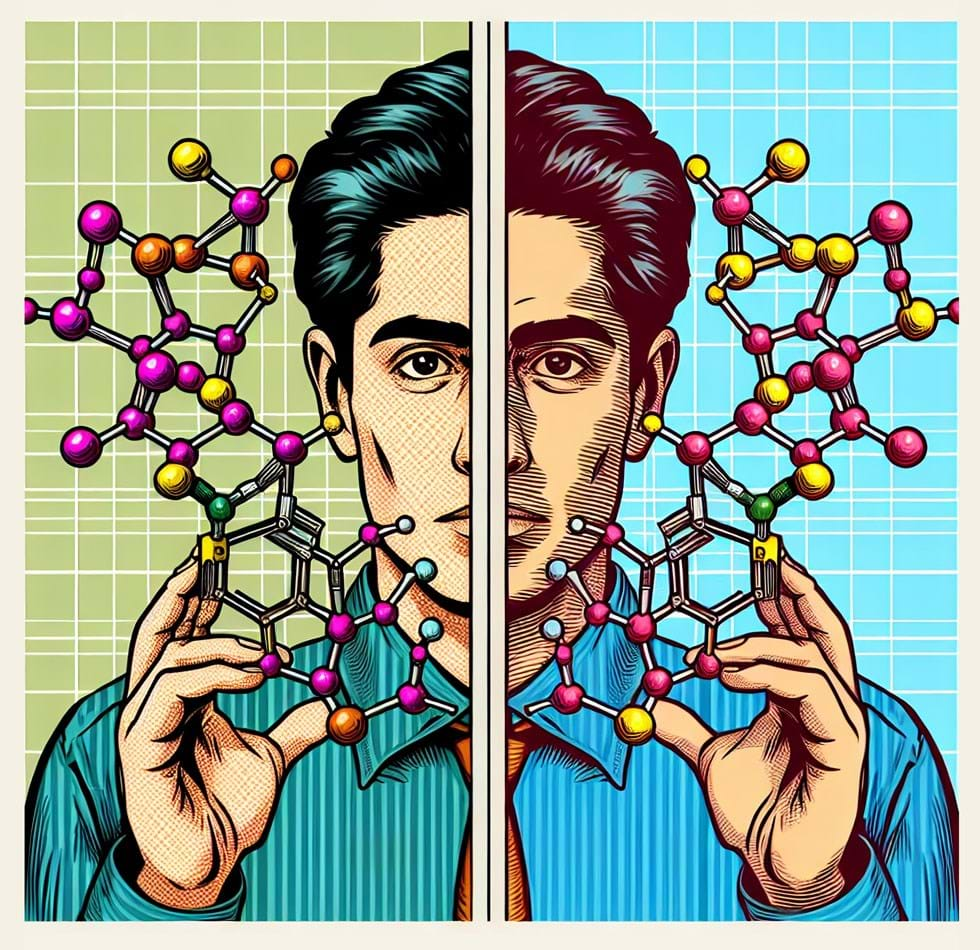How Mirror Life Could Change our Lives

Williams Olughu argues that harnessing the transformative potential of mirror life is essential to making it the defining groundbreaking technology of the future
Quick Read
- Potential of Mirror Life: Mirror molecules could enable more stable and effective therapeutics with fewer side effects
- Technical Challenges: Scaling mirror life requires breakthroughs in synthetic biology, including mirror biomolecule synthesis and nutrient supply
- Biosecurity Risks: Mirror organisms could evade immune systems and disrupt ecosystems, requiring strict containment and regulation
AS A child, I was fascinated at how my right hand magically became my left every time I looked into a mirror. I pondered why my reflection was the opposite of me; no easy answers came, but I lodged the question in my subconscious. This curiosity was reignited in a secondary school organic chemistry class, where I was introduced to isomers, particularly enantiomers. However, after many years, I am still left with lingering questions: Why is all known natural life homochiral? What makes an enantiomer vastly functionally different from its mirror image?
Mirror life refers to a hypothetical form of life in which essential molecules, such as DNA, RNA, and proteins, have the opposite handedness (chirality) compared to those found in all known natural life. However, the term hypothetical may no longer be entirely accurate. Rapid advancements in synthetic biology, genetic engineering, computational biology, artificial intelligence, automation, and robotics are converging to make mirror life an increasingly tangible reality.1
This prompted a warning from scientists in December’s issue of Science,2 of the “unprecedented and largely overlooked risks” of mirror organisms and calling on the global research community and industry to “chart an appropriate path forward”.
Isomers
Isomers are molecules with the same molecular formula but different structures or arrangements of atoms, leading to different properties.
Enantiomers
Enantiomers are mirror-image isomers that are non-superimposable, like left and right hands. They have identical physical properties but can behave very differently in biological systems.
Homochiral
Homochiral means having only one specific chirality of molecules in a biological system. For example, amino acids, the building blocks of proteins, are left-handed (L-form) in all known organisms. Sugars, like ribose in RNA (ribonucleic acid) and DNA, are right-handed (D-form) in all known life.
Exciting possibilities
The potential benefits mirror life could bring to bioprocess and biochemical engineering are genuinely exciting. Imagine the possibilities in novel biopharmaceuticals, with patients accessing therapeutic molecules based on D-peptides and D-proteins inherently more stable and less likely to trigger an immune response.3 These mirror-image molecules, built from D-amino acids instead of the natural L-forms, are resistant to degradation by our body’s proteases – enzymes that normally digest proteins by cutting them into smaller pieces.4 This could lead to a new class of drugs with superior pharmacokinetic properties, meaning they have a longer half-life and are potentially more effective in the body with fewer side effects. Furthermore, another tantalising prospect is using mirror organisms as production platforms to produce enantiopure L-sugars and other pharmaceutical compounds that are difficult to synthesise chemically.5 These same cell factories could manufacture materials and chemicals with unique functionality.
Beyond specific products, the idea of bioprocesses operating independently from natural biological systems is compelling.
Since mirror organisms operate with reversed chirality, they would likely be resistant to contamination by natural bacteria, phages, and other biological agents that rely on specific chiral interactions. This enhanced biocontainment could drastically simplify sterilisation protocols in industrial bioprocesses, making them more reliable and potentially more cost-effective. It’s akin to having a separate biological system that functions independently of the natural world’s inherent vulnerabilities.6
Challenges and risks
However, it’s impossible to discuss the potential of mirror life without confronting its significant challenges and risks. The sheer technical barriers to creating and scaling up mirror life are immense. Synthesising the necessary mirror biomolecules – genomes, proteomes, and so forth – is currently a technically challenging, expensive, and time-consuming endeavour.
A major bottleneck is constructing complex biological machinery like a mirror ribosome composed of multiple protein and nucleotide subunits. Even if we overcome these initial hurdles, developing robust and scalable methods for culturing and maintaining mirror organisms would require substantial breakthroughs in synthetic biology and biochemical engineering. Another crucial consideration is that these organisms will need nutrients of the opposite chirality to those used by natural life to achieve similar growth rates. Hence, the significant challenge is establishing reliable and cost-effective supply chains for such “mirror nutrients” or engineering mirror organisms to metabolise natural chiral compounds.
The emergence of mirror life will necessitate re-evaluating and adapting core biochemical engineering principles. Bioreactors designed for mirror organisms would likely require enhanced containment strategies, potentially involving multiple physical and biological barriers to prevent accidental release. Considering their reversed chirality, new methods for separating, purifying, and characterising mirror biomolecules would need to be developed. Engineering efficient metabolic pathways using mirror enzymes and substrates would be critical for optimising growth and bioproduction. Ultimately, biosecurity by design, incorporating inherent biocontainment mechanisms within mirror organisms, such as dependence on non-natural molecules for survival, will be paramount.Regarding risk, perhaps the most pressing concern revolves around biosecurity and biosafety. The potential for unintended release and environmental spread of mirror organisms is a significant worry. Mirror bacteria, for example, would likely evade natural immune systems and predators, which could result in lethal infections to plant and animal species, including humans. Even with stringent biocontainment measures, the possibility of accidental or deliberate misuse to create harmful mirror pathogens cannot be ruled out.
Mirror life’s potential environmental impact is also a source of apprehension. Their lack of natural checks and balances could allow them to become invasive species, colonising diverse environments and causing severe ecological disruption. The potential for irreversible environmental harm is a serious consideration, especially if invasive mirror bacteria were to impact keystone species or disrupt nutrient cycles.
Conclusion
Mirror biochemistry represents a scientific frontier with the potential for groundbreaking advancements in broad-ranging areas such as drug discovery, crystallography biosensors, and material/chemical synthesis. However, the significant technical hurdles and the profound biosecurity and biosafety risks of creating mirror life, especially the potential for irreversible ecological damage, demand a cautious and responsible approach. A balanced perspective requires us to acknowledge both the exciting possibilities and the very real dangers, emphasising the need for thorough risk assessment, robust regulatory frameworks, and open international dialogue as we navigate this uncharted territory.
References
1. F Rohden, J D Hoheisel, and HJ Wieden, Through the looking glass: milestones on the road towards mirroring life; Trends in Biochemical Sciences: https://bit.ly/3RjgNOv
2. KP Adamala et al, Technical Report on Mirror Bacteria: Feasibility and Risks: https://bit.ly/4c7zqP5
3. L Zhao and W Lu, Mirror image proteins; Current Opinions in Chemical Biology: https://bit.ly/425fLLc
4. KP Adamala et al, Confronting risks of mirror life; Science: https://bit.ly/4l4PTI0
5. BE Young, N Kundu, and JT Sczepanski, Mirror-Image Oligonucleotides: History and Emerging Applications; Chemistry – A European Journal: https://bit.ly/4c95iD5
6. AJ Lander, Y Jin, and LYP Luk, D-Peptide and D-Protein Technology: Recent Advances, Challenges, and Opportunities; ChemBioChem: https://bit.ly/3DIyrs6
Correction: The original text has been modified to more accurately reflect the distinction between mirror life and mirror molecules; and clarify the author’s expectations about the need for nutrients with opposite chirality.
Recent Editions
Catch up on the latest news, views and jobs from The Chemical Engineer. Below are the four latest issues. View a wider selection of the archive from within the Magazine section of this site.




